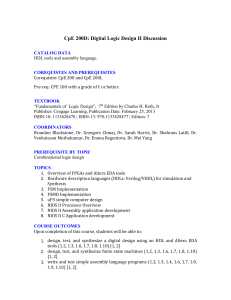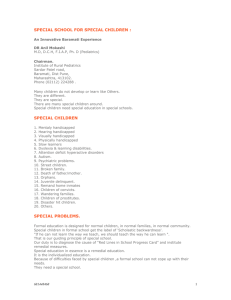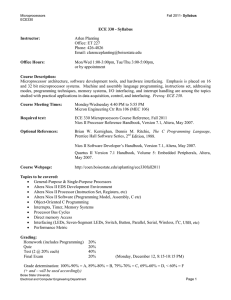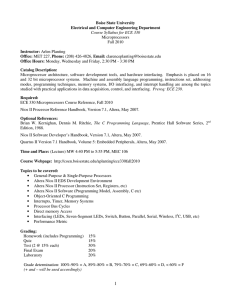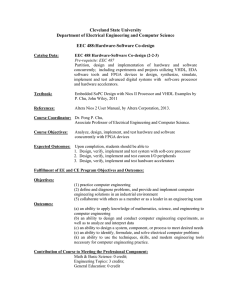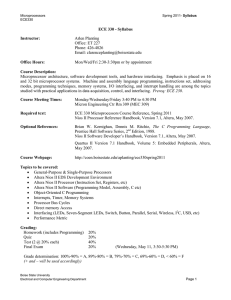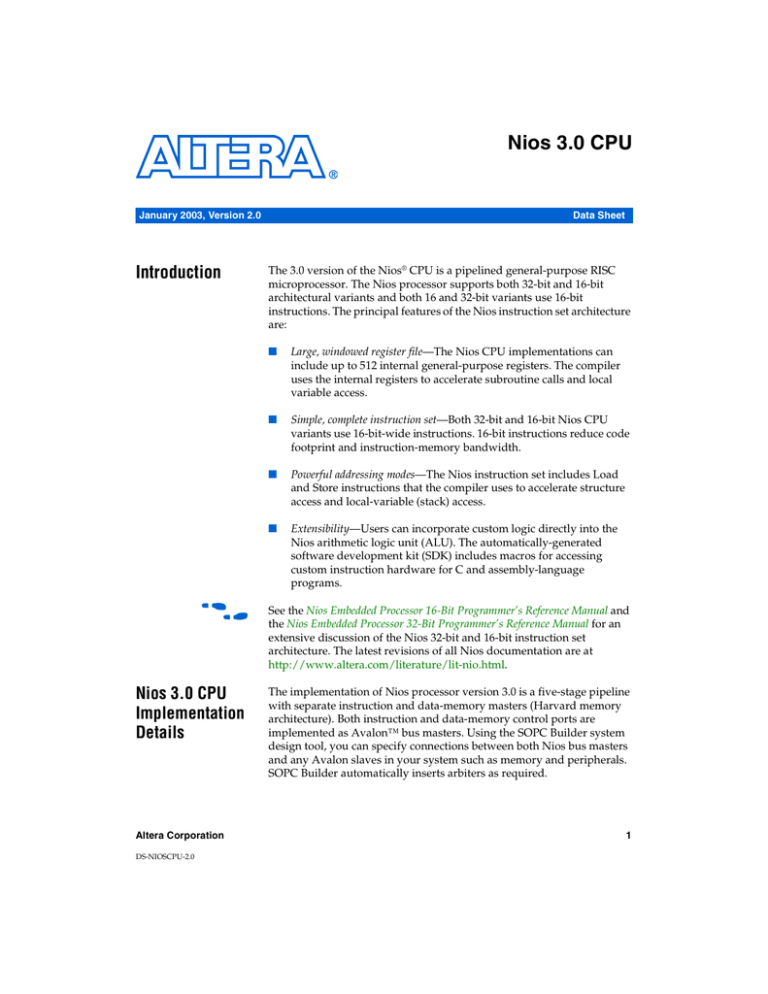
Nios 3.0 CPU
January 2003, Version 2.0
Introduction
f
Nios 3.0 CPU
Implementation
Details
Altera Corporation
DS-NIOSCPU-2.0
Data Sheet
The 3.0 version of the Nios® CPU is a pipelined general-purpose RISC
microprocessor. The Nios processor supports both 32-bit and 16-bit
architectural variants and both 16 and 32-bit variants use 16-bit
instructions. The principal features of the Nios instruction set architecture
are:
■
Large, windowed register file—The Nios CPU implementations can
include up to 512 internal general-purpose registers. The compiler
uses the internal registers to accelerate subroutine calls and local
variable access.
■
Simple, complete instruction set—Both 32-bit and 16-bit Nios CPU
variants use 16-bit-wide instructions. 16-bit instructions reduce code
footprint and instruction-memory bandwidth.
■
Powerful addressing modes—The Nios instruction set includes Load
and Store instructions that the compiler uses to accelerate structure
access and local-variable (stack) access.
■
Extensibility—Users can incorporate custom logic directly into the
Nios arithmetic logic unit (ALU). The automatically-generated
software development kit (SDK) includes macros for accessing
custom instruction hardware for C and assembly-language
programs.
See the Nios Embedded Processor 16-Bit Programmer’s Reference Manual and
the Nios Embedded Processor 32-Bit Programmer’s Reference Manual for an
extensive discussion of the Nios 32-bit and 16-bit instruction set
architecture. The latest revisions of all Nios documentation are at
http://www.altera.com/literature/lit-nio.html.
The implementation of Nios processor version 3.0 is a five-stage pipeline
with separate instruction and data-memory masters (Harvard memory
architecture). Both instruction and data-memory control ports are
implemented as Avalon™ bus masters. Using the SOPC Builder system
design tool, you can specify connections between both Nios bus masters
and any Avalon slaves in your system such as memory and peripherals.
SOPC Builder automatically inserts arbiters as required.
1
Nios 3.0 CPU Data Sheet
f
See the Avalon Bus Specification Reference Manual for details on the signals
and timing of Avalon bus transfers. See the SOPC Builder Data Sheet for
details on connecting and generating Nios processor systems.
Instruction Bus-Master
The Nios instruction master is a 16-bit wide, latency-aware Avalon bus
master. This master is only used to fetch instructions from memory that
will be executed by the Nios CPU. This master never performs any write
operations. Because this master is latency-aware, it can perform postedread operations to latent memory devices. The instruction master issues
new read requests before data is returned by the bus. Nios uses a branchnot-taken prediction scheme to issue speculative addresses. Native
support for latency minimizes the impact of latent memory and increases
the overall fMax of the system as a whole. Penalties occur only for mispredicted branches. The Nios instruction master can optionally
implement an on-chip cache memory for improving average instruction
fetch performance when accessing slower memory. See “Cache Memory”
on page 3.
The Avalon bus generated by SOPC Builder automatically includes
dynamic bus-sizing logic. Consequently, the Nios instruction master can
be connected to 8- 16- and 32-bit-wide memory.
f
See the Avalon Bus Specification Reference Manual for details on the signals
and timing of Avalon bus transfers.
Data Bus-Master
The Nios data master is 3.0 bits wide for 32-bit architecture variants and
16-bits wide for 16-bit architecture variants. The data master is used for
three purposes:
2
1.
To fetch data from memory when the CPU executes a loadinstruction (LD, LDP, LDS).
2.
To write data to memory when the CPU executes a store-instruction
(ST, STP, STS, ST8s, ST8d, ST16s, ST16d, STS8s, STS16s).
3.
To fetch interrupt-vectors from the interrupt-vector table when the
CPU executes a TRAP instruction or processes an internal or external
exception.
Altera Corporation
Nios 3.0 CPU Data Sheet
Because it is not meaningful to predict data addresses or continue
execution before data is retrieved, the Nios data master does not support
latency. Consequently, slave latency is seen by the data master as waitstates. Load and store operations can be completed in a single clock-cycle
when the Nios data master is connected to zero-wait-state memory. This
assumes there is no arbitration conflicts with other masters, including the
CPU’s own instruction-master.
For highest performance, the data master should be assigned higher
arbitration priority on any slave that is shared by both instruction and
data masters.
Cache Memory
The Nios CPU has optional cache memories on both the instruction master
(instruction cache) and the data master (data cache). Users enable the
hardware for instruction cache, data cache, or both, using the Nios
processor configuration wizard in SOPC Builder. The cache memory size
is configurable. Cache memory will reside on-chip.
Both instruction cache and data cache are direct-mapped caches, the
simplest implementation. Instructions and control registers in the Nios
architecture provide facilities for the user to enable and disable instruction
cache and data cache usage at runtime, as well as invalidate entries in the
cache memory.
In the event of a cache hit when the cache is enabled, memory load
operations execute in a single clock cycle. Cache misses introduce
additional cycles of latency. When the cache is disabled (either by
disabling the cache hardware or by temporarily disabling the cache in
software), memory accesses do not incur extra latency. When the cache is
enabled, memory store operations incur one or two additional cycles of
latency.
f
See the Nios Embedded Processor 32-Bit Programmer’s Reference Manual for
information on using the instruction and data cache memories.
1
Altera Corporation
The cache memory is only available in the 32-bit Nios CPU
architecture. The Nios cache memories can only be used in Altera
devices that offer the ALYSYNCRAM memory mode. At the
time of publishing, the Stratix, Stratix GX and Cyclone device
families support the Nios cache memory.
3
Nios 3.0 CPU Data Sheet
Shift Unit
The Nios processor uses fixed (non-configurable) barrel-shifter logic that
executes all shift instructions (ASR, ASRI, ASL, ASLI, LSL, LSLI, RLC and
RRC) in two clock cycles, regardless of the shift-distance.
Multiply Support
The Nios processor supports three different options for implementing
integer multiplication operations from software:
1.
The MUL Instruction–A 32-bit Nios CPU can optionally be configured
to include a hardware 16x16 –> 32 integer multiplier. This hardware
multiplier is used by the MUL instruction to compute a 32-bit result
in three or less clock cycles. When the MUL option is selected, the
MUL instruction uses the C-runtime libraries in the automaticallygenerated SDK to implement multiplication.
1
This option is not supported in the 16-bit Nios instruction set.
The MUL instruction takes 1 to 3 clock cycles to compute a 32-bit
result, depending on the device family used. For example, when
using the MUL option in Altera® StratixTM devices, the hardware
multiplier is implemented in the Stratix fast DSP blocks, and the
operation can complete in a single clock cycle. In other device
families, the hardware multiplier is implement in general logic
elements, the MUL instruction may take up to 3 clock cycles to
complete.
2.
The MSTEP Instruction– A 32-bit Nios CPU can optionally be
configured to include hardware for executing one step of a 16x16
multiply. This hardware is used by the MSTEP instruction to
produce a partial multiplication result in two clocks. When the
MSTEP option is selected, the C-runtime libraries in the
automatically-generated SDK implements multiplication operations.
It does this by issuing strings of successive MSTEP operations such
as 16-sequential MSTEPs to perform a 16x16 –> 32 multiplication.
The amount of logic resources needed to implement MSTEP is less
than 5% of the total CPU logic. Since the amount is so small, the
MSTEP option is the default.
1
4
This option is not supported in the 16-bit Nios instruction set.
Altera Corporation
Nios 3.0 CPU Data Sheet
3.
Software Multiplication–The C-runtime libraries in the automatically
generated SDK implement integer multiplication with sequences of
shift and add instructions when neither MSTEP nor MUL options are
enabled. Software multiplication gives the smallest possible CPU
logic utilization, but the slowest execution of multiplication
operations.
Interrupt Support
Version 3.0 of the Nios processor allows optional removal of support for
TRAP instructions, hardware interrupts, and internal exceptions. This
option is intended for use only in Nios systems where the processor is
implementing a very simple control function (that is, not running complex
software). When so configured, the Nios processor will not:
■
■
■
Include an irq input-pin
Process exceptions (TRAP instruction behavior is undefined)
Generate exceptions when a SAVE or RESTORE instruction
underflows/overflows the register file
Select this option only if:
■
■
■
■
You want the smallest possible Nios CPU core.
You know absolutely that your application software does not
generate register-window underflow/overflow exceptions. That is,
the subroutine call-depth is less than the number of available registerwindows.
You do not have any hardware interrupt sources.
Your assembly-language code does not include TRAP instructions.
1
The Nios SDK does not generate TRAP instructions in compiled
code. By default, interrupt support is enabled. TRAPs,
interrupts, and exceptions work exactly as described in the Nios
Embedded Processor 16-Bit Programmer’s Reference Manual and the
Nios Embedded Processor 32-Bit Programmer’s Reference Manual.
Nios On-Chip Instrumentation Debug Module
The Nios CPU has an optional on-chip JTAG debug module that allows
communication with the CPU via the standard JTAG pins on the Altera
device. The debug module is an intellectual property (IP) core designed by
First Silicon Solutions (FS2) Inc. It is implemented as an FS2 On-Chip
Instrumentation (OCITM) block that connects directly to signals internal to
the Nios CPU. Hereafter, the debug module is referred to as the Nios OCI
debug module.
Altera Corporation
5
Nios 3.0 CPU Data Sheet
The Nios OCI debug module may be configured to implement run
control, hardware breakpoints and software trace. The OCI debug module
stores trace data in either on-chip memory or in an external system
analyzer (for example, the ISA-NIOS in-system analyzer by FS2. The Nios
OCI debug module can read and write registers and memory, allowing
easy download of software to memory and examination of registers
during program execution. The Nios OCI debug module has nonmaskable control of CPU execution. It does not require a software stub to
operate, and can seize control at any time during software execution.
Some advanced debug features require external JTAG-based debug
hardware and/or a third-party debugger. In addition to debug
functionality, the Nios OCI debug module can be used for stdio. See
“Software Subroutines” for more details.
f
Software
Subroutines
See the Nios Embedded Processor Software Development Reference Manual for
information about using the Nios OCI debug module for software
debugging.
The following sections describes the Nios library software subroutines
available for using the Nios OCI debug module and for manipulating the
Nios instruction and data caches.
JTAG Character I/O Subroutines
The Nios CPU can communicate with a host computer connected to the
OCI debug module via a JTAG download cable. When the Nios OCI
debug module is enabled and Host Communication (maincomm_slave)
is set to oci_core in SOPC Builder, the SDK generated by SOPC Builder
includes software subroutines for stdio via the OCI debug module. The
subroutines do not conflict with JTAG debug, and can be used
simultaneously while the OCI debug module is performing debug
operations.
1
6
Using JTAG for character I/O is significantly slower than UART
communication.
Altera Corporation
Nios 3.0 CPU Data Sheet
Table 1 lists the software subroutines available in the custom SDK library.
These functions are declared in the SDK include file excalibur.h.
nasys_printf_uart (in excalibur.h) will be defined to be the base
address of the Nios OCI debug module (even though the OCI debug
module is not a UART). Therefore, printf can be used to send formatted
strings to a host computer via the OCI debug module.
Table 1. JTAG Software Subroutines
Subroutine
nr_jtag_rxchar
Reads a character from the Nios OCI debug module
whose base address is passed as an argument.
nr_jtag_tx_ready
Returns non-zero (true) if JTAG IO is ready to
transmit a character, otherwise zero (false).
nr_ jtag_txchar
Sends a single character to the Nios OCI debug
module whose base address is passed as an
argument.
nr_ jtag_txcr
Sends a carriage return and line feed to the Nios OCI
debug module with base address defined by
nasys_printf_uart
Prints an integer value, in hexadecimal, to the Nios
OCI debug module with base address defined by
nasys_printf_uart.
Prints the value of a short integer, in hexadecimal, to
the Nios OCI debug module with base address
defined by nasys_printf_uart.
Prints the value of a long integer, in hexadecimal, to
the Nios OCI debug module with base address
defined by nasys_printf_uart.
Prints a null-terminated string to the Nios OCI debug
module with base address defined by
nasys_printf_uart.
nr_ jtag_txhex
nr_ jtag_txhex16
nr_ jtag_txhex32
nr_ jtag_txstring
f
Description
See the Nios Embedded Processor Software Development Reference Manual for
printf implementation details and communication with a host
computer.
nr_jtag_rxchar
This subroutine reads a character from the Nios OCI debug module. The
Nios OCI debug module’s base address is passed in as pointer ociBase.
If no character is waiting, nr_jtag_rxchar returns -1. If zero is passed
for the base address, nr_jtag_rxchar reads a character from the Nios
OCI debug module at the base address defined by nasys_printf_uart
(in excalibur.h).
Altera Corporation
7
Nios 3.0 CPU Data Sheet
Syntax
int nr_jtag_rxchar( const void *ociBase );
Parameter
The ocibase parameter is a pointer to the Nios OCI debug module.
Example
#include "excalibur.h"
void main()
{
int c;
printf( "Please enter a character:\n" );
while( ( c = nr_jtag_rxchar( 0 ) ) == -1 )
; // wait for valid input
printf( "Your character is:\t%c\n", c );
}
nr_jtag_tx_ready
This subroutine returns a non-zero value (true) if JTAG IO is ready to
transmit a character. If JTAG IO is not ready to transmit (because the host
is not receiving previously transmitted characters), it will return zero
(false). The Nios OCI debug module base address should be passed as
ociBase. If zero is passed as the base address, the base address will default
to nasys_printf_uart (in excalibur.h).
Syntax
int nr_jtag_tx_ready( const void* ociBase );
Parameter
The ociBase parameter is a pointer to the Nios OCI debug module.
Example
#include "excalibur.h"
#define kLineWidth
#define kLineCount
77
100
#define kTimeout
1000
int my_jtag_txchar( int c, int timeout )
{
int ms = nr_timer_milliseconds();
8
Altera Corporation
Nios 3.0 CPU Data Sheet
int ready = 0;
while ( nr_timer_milliseconds() < ( ms + timeout ) )
{
if ( ready = nr_jtag_tx_ready( na_cpu_oci_core) )
break;
}
if ( ready )
nr_jtag_txchar( c, na_cpu_oci_core );
return ready;
}
int my_jtag_txcr( int timeout )
{
if ( ! my_jtag_txchar( 13, timeout ) )
return 0;
return my_jtag_txchar( 10, timeout );
}
int main()
{
char c;
int i,j;
int mix;
// install the timer ISR and start timing
nr_timer_milliseconds();
printf( "\n\nPress character, or <space> for mix:" );
while( ( c = nr_rxchar() ) < 0 )
;
printf( "%c\n\n",c );
// Don't show unprintables
if( c < 32 )
c = '.';
mix = c==' ';
for( i = 0; i < kLineCount; i++ )
{
for( j = 0; j < kLineWidth; j++ )
{
if( mix )
{
c++;
if( c >= 127 )
c = 33;
}
if ( ! my_jtag_txchar( c, kTimeout ) )
{
printf( "ERROR: my_jtag_txchar exceeded timeout (%i
ms)\n", kTimeout );
return;
}
Altera Corporation
9
Nios 3.0 CPU Data Sheet
}
my_jtag_txcr( kTimeout );
}
my_jtag_txcr( kTimeout );
my_jtag_txcr( kTimeout );
printf( "\n\nDone.\n" );
}
nr_jtag_txchar
This subroutine sends a single character, c, to the Nios OCI debug module
whose base address is passed as ociBase. If zero is passed for the base
address, nr_jtag_txchar sends a character to the Nios OCI debug
module at the base address defined by nasys_printf_uart (in
excalibur.h).
1
nr_jtag_rxchar will not return until the OCI transmit
readybit is clear. If the host is not receiving characters,
nr_jtag_txchar will loop forever. This will affect all other
subroutines nr_jtag_tx that call nr_jtag_txchar.
Syntax
void nr_jtag_txchar( int c, const void *ociBase );
Parameters
nr_jtag_txchar Parameters
Parameter Name
Description
c
Character to be sent
ociBase
Pointer to the Nios OCI debug
module
nr_jtag_txcr
This subroutine sends a carriage return and line feed to the Nios OCI
debug module with base address defined by nasys_printf_uart (in
excalibur.h).
Syntax
void nr_jtag_txcr( void );
10
Altera Corporation
Nios 3.0 CPU Data Sheet
nr_jtag_txhex
This subroutine prints the integer value of x in hexadecimal to the Nios
OCI debug module with base address defined by nasys_printf_uart
(in excalibur.h). The range for a 16-bit Nios CPU is 0x0000 to 0xFFFF, and
for a 32-bit Nios CPU is 0x00000000 to 0xFFFFFFFF.
Syntax
void nr_jtag_txhex( int x );
Parameter
The x parameter is an integer value to be sent to the Nios OCI debug
module.
nr_jtag_txhex16
This subroutine prints the 16-bit value of x in hexadecimal to the Nios OCI
debug module with base address defined by nasys_printf_uart (in
excalibur.h). The range is from 0x0000 to 0xFFFF.
Syntax
void nr_jtag_txhex16( short x );
Parameter
The x parameter is a 16-bit integer value to be sent to the Nios OCI debug
module.
nr_jtag_txhex32
This subroutine prints the 32-bit value of x in hexadecimal to the to Nios
OCI debug module with base address defined by nasys_printf_uart
(in excalibur.h). The range is from 0x00000000 to 0xFFFFFFF. This
subroutine is not available on a 16-bit Nios CPU.
Syntax
void nr_jtag_txhex32( long x );
Parameter
The x parameter is a 32-bit integer value to be sent to the Nios OCI debug
module.
Altera Corporation
11
Nios 3.0 CPU Data Sheet
nr_jtag_txstring
This subroutine prints the null-terminated string s to the Nios OCI debug
module with base address defined by nasys_printf_uart (in
excalibur.h).
Syntax
void nr_jtag_txstring( const char *s );
Parameter
The s parameter is a pointer to a null-terminated character string.
Cache Management Software Subroutines
The job of the data cache and one of the jobs of the nios-elf-gcc optimizing
compiler is to reduce bus traffic to memory. Both the data cache and the
compiler do this by keeping track of recent reads and writes to particular
memory locations, and using those recent reads—or even implied values
–instead of actual memory accesses when possible.
This strategy assumes that memory doesn’t change except when the
software running changes it.This strategy fails if the memory is shared
with another CPU that can change it, or if the locations accessed are
hardware peripherals.
For such accesses, you must tell the compiler both not to optimize and not
to access the data cache by declaring the type of accessed memory
volatile. This causes the compiler to always access the memory, and
also – if the – mdcache option is used, to emit PFXIO instructions.
Here is an example of the volatile keyword for a peripheral structure.
// UART Registers
typedef volatile struct
{
int np_uartrxdata;
int np_uarttxdata;
int np_uartstatus;
int np_uartcontrol;
int np_uartdivisor;
int np_uartendofpacket;
} np_uart;
12
//
//
//
//
//
//
Read-only, 8-bit
Write-only, 8-bit
Read-only, 8-bit
Read/Write, 9-bit
Read/Write, 16-bit, optional
Read/Write, end-of-packet character
Altera Corporation
Nios 3.0 CPU Data Sheet
The following subroutines are available in the Nios library for
manipulating the Nios instruction and data caches. These subroutines
only work correctly in a Nios system which has been built with the
corresponding cache enabled.
void nr_icache_init(void);
This subroutine clears the instruction cache and enables it. The Nios
library calls this subroutine before your main() subroutine on systems
which have an instruction cache.
void nr_dcache_init(void);
This subroutine clears the data cache and enables it. The Nios libraries call
this subroutine before your main() subroutine on systems which have a
data cache.
void nr_icache_invalidate_lines(void *low_address, void *high_address);
This subroutine clears a portion or all of the instruction cache that
corresponds to the address range passed. The range includes the low
address and excludes the high address.
void nr_dcache_invalidate_lines(void *low_address, void *high_address);
This subroutine clears a portion or all of the data cache that corresponds
to the address range passed. The range includes the low address excludes
the high address.
void nr_dcache_enable(void);
This subroutine enables the data cache.
void nr_dcache_disable(void);
This subroutine disables the data cache.
void nr_icache_enable(void);
This subroutine enables the instruction cache.
void nr_icache_disable(void);
This subroutine disables the instruction cache.
Altera Corporation
13
Nios 3.0 CPU Data Sheet
PTF
Assignments
The Nios 3.0 CPU configuration options are determined by assignments
in your system PTF file. Each Nios CPU will have a corresponding
MODULE section in your system PTF containing the assignment:
class = “altera_nios”;
Table 2 lists the CPU’s PTF assignments followed by a detailed
description. These assignments are found in the
MODULE/WIZARD_SCRIPT_ARGUMENTS section unless otherwise noted
and are used by the Nios generator-program to control HDL and SDK
generation.
Table 2. CPU PTF Assignments (Part 1 of 2)
Assignment
Type
Allowed Values
Default
Requires
cache_dcache_size_k
Integer
(1)
0
cache_has_dcache
cache_has_dcache
Boolean
1, 0
0
cache_has_icache
Boolean
1, 0
0
cache_icache_size_k
Integer
(1)
0
CPU-related
String
nios_32, nios_16
nios_32
implement_forward_b1
Boolean
1, 0
1
mstep
Boolean
1, 0
1
multiply
Boolean
1, 0
0
num_regs
Integer
128, 256, 512
256
CPU_Architecture
reset_offset
hexadecimal integer any hexidecimal integer
(byte-offset)
in the range 00xFFFFFFFF
None (must be
specified)
reset_slave
String (module/slave slash-delimited (“/”) path
section path name)
to slave section
None (must be
specified)
rom_decoder
Boolean
1, 0
1
support_interrupts
Boolean
1, 0
1
support_rlc_rcc
Boolean
1, 0
0
vecbase_offset
hexadecimal integer any hexidecimal integer
(byte-offset)
in the range 00xFFFFFFFF
None (must be
specified)
vecbase_slave
String
slash-delimited (“/”) path
(module/slave
to slave section
section path name)
None (must be
specified)
wvalid_wr
14
Boolean
1, 0
cache_has_icache
0
Altera Corporation
Nios 3.0 CPU Data Sheet
Table 2. CPU PTF Assignments (Part 2 of 2)
Assignment
Type
Allowed Values
Default
Requires
SDK-related
datamem_slave
String (module/slave slash-delimited (“/”) path
section path name)
to slave section
None (must be
specified)
debugcomm_slave
String (module/slave slash-delimited (“/”) path
section path name)
to slave section
None (must be
specified)
germs_monitor_id
String (10
characters or fewer)
Any ASCII string, max
10 characters
“” (empty
string)
maincomm_slave
String (module/slave slash-delimited (“/”) path
section path name)
to slave section
None (must be
specified)
mainmem_slave
String (module/slave slash-delimited (“/”) path
section path name)
to slave section
None (must be
specified)
Debug-related
include_oci
Other
smart_recompile
(1)
Boolean
1, 0
0
Any power of 2 (i.e. 0,1,2,4,8,16,32). If cache_hex_(X)cache is on, the cpu assignment must be > 0.
cache_dcache_size_k Assignment
This assignment assigns the data cache size, in kilobytes. Acceptable
values for this assignment must be powers of two. For instance, a value of
1 creates a data cache of 1 KB (1024 bytes), which equates to 256 cache lines
(one 32-bit word per line). The data cache may not be bigger than one
quarter of the addressable space of the Nios data master. For instance, if
the data master can addresses locations between 0x0 and 0xfff (a 4 KB
range), the data cache size is restricted to 1 KB. Thus, the upper limit of the
cache size is design-dependent.
Altera Corporation
15
Nios 3.0 CPU Data Sheet
cache_has_dcache Assignment
This assignment enables use of the data cache. The data cache option is
only valid for the 32-bit Nios architecture; a 16-bit Nios CPU cannot
enable the cache_has_dcache. This assignment must be used in
conjunction with the cache_dcache_size_k assignment. The data
cache requires Altera device architectures with ALTSYNCRAM memory
blocks, such as the Cyclone and Stratix device families.
cache_has_icache Assignment
This assignment enables use of the instruction cache. The instruction
cache option is only valid for the 32-bit Nios architecture; a 16-bit Nios
CPU cannot enable cache_has_icache. This assignment must be used
in conjunction with the cache_icache_size_k assignment. The
instruction cache requires Altera device architectures with
ALTSYNCRAM memory blocks, such as the Cyclone and Stratix device
families.
cache_icache_size_k Assignment
This assignment assigns the instruction cache size, in kilobytes.
Acceptable values for this assignment must be powers of two. For
instance, a value of 1 creates a data cache of 1 KB (1024 bytes), which
equates to 512 cache lines (one 16-bit instruction word per line). The data
cache may not be bigger than one quarter of the addressable space of the
Nios instruction master. For instance, if the instruction master can
addresses locations between 0x0 and 0xfff (a 4 KB range), the instruction
cache size is restricted to 1 KB. Thus, the upper limit of the cache size is
design-dependent.
CPU_Architecture Assignment
This assignment selects which architecture variant (32-bit/16-bit) will be
generated. When CPU_Architecture is nios_16, logic will be
generated that implements the 16-bit instruction set architecture (16-bitwide registers, ALU, and data bus-master), as described in the Nios
Embedded Processor 16-Bit Programmer’s Reference Manual. Also, the
Data_Width assignment in the MASTER data
master/SYSTEM_BUILDER_INFO section must be set to 16.
When CPU_Architecture is nios_32, logic will be generated that
implements the 32-bit instruction set architecture (32-bit-wide registers,
ALU, and data bus-master), as described in the Nios Embedded Processor 32Bit Programmer’s Reference Manual. Also, the Data_Width assignment in
the MASTER data master/SYSTEM_BUILDER_INFO section must be set
to 32.
16
Altera Corporation
Nios 3.0 CPU Data Sheet
In either case, the SDK associated with this CPU will be generated with the
correct libraries and default compiler options necessary to create software
for the selected architecture variant.
implement_forward_b1
This assignment controls the CPU’s handling of certain types of pipelinedata hazards. The CPU always hides all pipeline implementation details
from software, and behaves exactly as indicated in the Nios Embedded
Processor 32-Bit Programmers’ Reference Manual and Nios Embedded
Processor 16-Bit Programmer’s Reference Manual regardless of this setting.
When implement_forward_b1 = 1, the CPU will include a dataforwarding multiplexer on the B input of the ALU. This allows the CPU to
process an instruction stream where the B operand of an instruction is
modified by the previous instruction without introducing a stall cycle in
between. This reduces the number pipeline stalls at the expense of some
additional logic (~32 LEs) and a potential reduction in fMax.
Most compiled code does not encounter this class of data hazard very
often. Performance on the Dhrystone benchmark (at a fixed clock
frequency) is improved by about three percent when
implement_forward_b1 = 1. When implement_forward_b1 = 0, the CPU
will stall for one clock-cycle when the operand of an instruction was
modified by its immediate predecessor.
mstep Assignment
This assignment may be set to 1 only for 32-bit Nios cores. When mstep =
1, the generated Nios CPU includes hardware that implements the MSTEP
instruction. The generated SDK makes use of MSTEP in the C-runtime
libraries. When mstep = 0, the MSTEP instruction is not implemented,
and the C-runtime libraries will not use it.
multipy Assignment
This assignment may be set to 1 only for 32-bit Nios cores. When
multiply = 1, the generated Nios CPU includes hardware that
implements the MUL instruction, and the generated SDK makes use of
MUL in the C-runtime libraries. When multiply = 0, the MUL
instruction is not implemented, and the C-runtime libraries will not use it.
Issuing the MUL instruction when multiply = 0 produces an undefined
result.
Altera Corporation
17
Nios 3.0 CPU Data Sheet
num_regs Assignment
This assignment value determines the total number of registers
implemented in the CPU’s windowed-register file. Larger register files
use more on-chip memory resources. Larger register files allow deeper
subroutine-nesting before a register-window underflow exception is
generated. With 128 registers, software can call subroutines 7-levels deep
before an underflow exception is generated. With 512 registers, software
can call subroutines 31-levels deep before an underflow exception is
generated. Software that frequently generates underflow/overflow
exceptions may experience significant performance degradation. In
practice, even complicated software can live comfortably in 512 registers
although recursive algorithms can cause even simple software to execute
very deep-subroutine nesting. The best setting for num_regs depends on
the complexity and performance requirements of the application software
and the amount of on-chip memory resources available.
reset_offset Assignment
See “reset_slave Assignment” on page 18 for reset_offset assignment
information.
reset_slave Assignment
The Nios CPU logic is generated with a built-in reset address. The value
of the reset address is derived from two PTF assignments: reset_slave
and reset_offset. The reset_slave assignment is used to extract a
base-address from the slave port of the specified slave-port on the
specified module. The reset_offset assignment specifies a byte-offset
that is applied to the indicated devices’s base-address.
<reset-address> = base-address-of-reset_slave + reset_offset;
After system reset is asserted and released, the CPU will fetch its first
instruction from the computed reset-address. For example, consider a
system with a Nios CPU and an on-chip memory module named
boot_rom mapped at base-address 0x400. In this example, suppose the
on-chip memory module has a single slave-port named s1. Suppose that
this memory contains the CPU’s startup program based at the beginning
of the memory.
To construct a CPU which executes this startup program at reset, that is
with a reset-address of 0x400, set the following PTF-assignments:
reset_slave = “boot_rom/s1”;
reset_offset = “0x0”;
18
Altera Corporation
Nios 3.0 CPU Data Sheet
rom_decoder Assignment
The Nios CPU includes internal instruction-decode logic that takes the
incoming 16-bit instruction word as input and produces approximately 80
control signals that determine the operation performed by the data path
logic. A significant portion of the instruction-decoder logic can be
implemented either as logic elements (LEs) or as an internal ROM memory.
When rom_decoder = 1, embedded memory is used in the instruction
logic, saving approximately 52-58 LEs. The exact savings depends on which
other CPU options have been selected. When rom_decoder = 0, no
memory resources are used in the instruction decoder.
support_interrupts Assignment
When the assignment support_interrupts = 0, the Nios CPU will
have neither irq nor irqnumber input signals on its Avalon bus master
interface and therefore cannot receive hardware interrupts. The CPU will
not generate internal exceptions for register-window underflows and
overflows. The results of executing a TRAP instruction is undefined.
In short, the CPU does not support interrupts, exceptions, or TRAP
instructions. See “Interrupt Support” on page 5 for a description of when
systems may use a CPU with no interrupt support.
When support_interrupts = 1, the Nios CPU will support interrupts,
exceptions, and traps exactly as described in the Nios Embedded Processor
32-Bit Programmer’s Reference Manual and Nios Embedded Processor 16-Bit
Programmer’s Reference Manual. By default, interrupt support is enabled,
and support_interrupts is 1.
support_rlc_rrc Assignment
These instructions rotate a register right or left (respectively) by one bit
through the carry flag. These instructions are never used by the compiler.
Support for these instructions requires some dedicated logic (between 1221) that can usually be saved. When assignment support_rlc_rrc = 0,
the CPU does not support these instructions, and the behavior of both
RRC and RLC instructions is undefined. When assignment
support_rlc_rrc = 1, the CPU supports RLC and RRC instructions.
Use this setting if you have written any assembly-language software that
explicitly uses these instructions.
f
Altera Corporation
See the complete Nios instruction set including the RRC and RLC
instructions in the Nios Embedded Processor 32-Bit Programmer’s Reference
Manual and Nios Embedded Processor 16-Bit Programmer’s Reference Manual.
19
Nios 3.0 CPU Data Sheet
vecbase_offset Assignment
See “vecbase_slave Assignment” on page 20 for more information.
vecbase_slave Assignment
The Nios CPU logic is generated with a built-in vector-table base address.
The vector-table address is derived from two PTF assignments:
vecbase_slave and vecbase_offset. The vecbase_slave
assignment is used to extract a base address from the slave port of the
specified slave port on the specified module. The vebase_offset
assignment specifies a byte offset which is applied to the indicated
devices’ base address.
<vector-table-base-address> = base-address-of-vecbase_slave + vecbase_offset;
Whenever an exception is processed due to external hardware interrupt,
internal exception, or execution of a TRAP instruction, the CPU fetches
exception-handler addresses from the vector table at this computed
address. For example, consider a system with a Nios CPU and a 4K
memory module named general_purpose_ram mapped at base
address 0x1000. In this example, suppose the on-chip memory module
has a single slave port named s1. Suppose the highest 256 bytes, the size
of the vector-table for 32-bit Nios CPU, is used as the vector table. To
construct a CPU that uses the memory region starting at 0x1F00 as its
vector table, set the following PTF assignments:
vecbase_slave = “general_purpose_ram/s1”;
vecbase_offset = “0xF00”;
f
20
The Nios Embedded Processor 16-Bit Programmer’s Reference Manual and Nios
Embedded Processor 32-Bit Programmer’s Reference Manual contains a
detailed description of the exception-handling process.
Altera Corporation
Nios 3.0 CPU Data Sheet
wvalid_wr Assignment
Control-register number 2 (%ctl2) is the WVALID register. Software can
always read this register to determine the limits of travel on current
window pointer (CWP). WVALID determines when underflow and
overflow exceptions are generated. A detailed description of the WVALID
register appears in the Nios Embedded Processsor 32-Bit Programmer’s
Reference Manual and Nios Embedded Processor 16-Bit Programmer’s
Reference Manual. Regardless of the setting of wvalid_wr, the WVALID
register is initialized at reset so that the entire windowed register file is
available to software (LO_LIMIT = 1 and HI_LIMIT = <number-ofregisters> - 2). The vast majority of compiled programs never need to
alter the initially-set WVALID value.
The default CWP-manager library included in the automaticallygenerated SDK never writes the WVALID register. When the PTFparameter wvalid_wr = 0, the WVALID register is not writable. A
WRCTL instruction with %ctrl2 as the destination has no effect. By
implementing WVALID read-only, the total logic utilization of the CPU is
reduced by approximately 15 LEs. Also, WVALID is protected from
accidental modification by errant software.
When wvalid_wr = 1, WVALID is implemented as a readable and
writable register. Software can modify WVALID by performing a WRCTL
instruction with %ctrl2 as the destination. Some real-time operating
system (RTOS) software may modify WVALID, for example, partitioning
the register file into kernel and user segments. Such RTOS software will
require a writable WVALID register (wvalid_wr = 1) in order to run
correctly.
1
Check the manufacturer’s documentation for your RTOS
software to determine its CPU hardware requirements.
datamem_slave Assignment
The Nios CPU is generated along with a custom SDK including libraries,
example programs, and utilities. C programs are, by default, compiled
with their stack, heap (malloc data) and writable global variables within
the system’s designated data-memory device. This PTF assignment is
used to designate the memory device where, by default, compiled
programs’ writable data will be located. The generated SDK is aware of
the vector table, and will locate the stack and heap to avoid conflicts.
Altera Corporation
21
Nios 3.0 CPU Data Sheet
debugcomm_slave Assignment
The Nios CPU is generated along with a custom SDK including libraries,
example programs, and utilities. One such utility is a resident GDB stub
which communicates with host debugging software over a designated
serial device (Avalon UART). The PTF assignment debugcomm_slave
designates which Avalon UART is used by the debug stub. It can be the
same UART as the maincomm_slave, but it is generally easier to debug
systems with separate debugcomm_slave and maincomm_slave
UARTs.
1
The designated device must be an Avalon UART.
germs_monitor_id Assignment
The Nios CPU is generated along with a custom SDK including libraries,
example programs, and utilities. One of the several programs generated
as part of the Nios SDK is a customized GERMS monitor (boot-monitor
program). The GERMS monitor prints a message at start up. The contents
of this message are taken from the CPU’s germs_monitor_id
assignment. It is often useful to set different id messages to display
different hardware revision levels of your system.
maincomm_slave Assignment
The Nios CPU is generated along with a custom SDK including libraries,
example programs, and utilities. Some libraries and utilities implicitly
make use of a standard output or console device, for example, the printf
library. The SDK uses a designated Avalon slave peripheral as the default
I/O device for many text input-output functions. The PTF assignment
maincomm_slave designates which slave peripheral is used by the
generated SDK for default text I/O.
1
There are two designated slave peripherals: OCI debug module
and UART. The designated slave peripheral must have the PTF
assignment Is_Printable_Device = 1.
mainmem_slave Assignment
The Nios CPU is generated along with a custom SDK including libraries,
example programs, and utilities. C programs are, by default, compiled to
reside at a base address within the system’s designated main-memory
device. This PTF assignment is used to designate the memory device
where, by default, compiled programs will be located. The generated SDK
is aware of the vector table, and will set the base address of compiled
programs to avoid the vector-table if, for example, the vector table is
mapped at the beginning of the designated main memory device.
22
Altera Corporation
Nios 3.0 CPU Data Sheet
include_oci Assignment
The Nios on-chip instrumentation (OCI) Debug Module is enabled with
the include_oci parameter. The Nios OCI debug module must be
enabled and configured using the Nios CPU configuration wizard.
Several other PTF assignments are used to specify parameters for the OCI
debug module. Only the configurations specified by SOPC Builder are
supported. These PTF assignments are: include_oci,
oci_offchip_trace, oci_onchip_trace, oci_num_xbrk,
oci_type, oci_num_dbrk, oci_dbrk_trace, oci_dbrk_pairs, and
oci_debugreq_signals.
When include_oci = 1, the Nios CPU includes on-chip logic and
memory resources required to implement JTAG-based software debug
and optional trace features. In addition, the CPU is generated with an
Avalon slave port named oci_core. Using the SOPC Builder GUI,
designers can assign any valid base address to the oci_core slave port.
Only debug tools access the oci_core memory space; software designers
should not access oci_memory.
smart_recompile Assignment
This assignment, when set (1), enables a make-like functionality of the
Nios generator program. The HDL representing the Nios CPU (and
associated memory contents and simulation files) will be generated only
if the parameters that influence the CPU have changed.
When the option is set to the default setting, clear (0), the CPU is always
regenerated, even if doing so results in output files identical to the
previous generation.
Altera Corporation
23
Nios 3.0 CPU Data Sheet
101 Innovation Drive
San Jose, CA 95134
(408) 544-7000
www.altera.com
Applications Hotline:
(800) 800-EPLD
Literature Services:
lit_req@altera.com
24
Copyright © 2003 Altera Corporation. All rights reserved. Altera, The Programmable Solutions Company, the
stylized Altera logo, specific device designations, and all other words and logos that are identified as
trademarks and/or service marks are, unless noted otherwise, the trademarks and service marks of Altera
Corporation in the U.S. and other countries. All other product or service names are the property of their
respective holders. Altera products are protected under numerous U.S. and foreign patents and pending
applications, mask work rights, and copyrights. Altera warrants performance of its
semiconductor products to current specifications in accordance with Altera’s standard
warranty, but reserves the right to make changes to any products and services at any time
without notice. Altera assumes no responsibility or liability arising out of the application
or use of any information, product, or service described herein except as expressly agreed
to in writing by Altera Corporation. Altera customers are advised to obtain the latest
version of device specifications before relying on any published information and before
placing orders for products or services.
Altera Corporation

